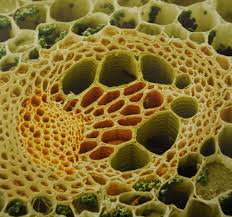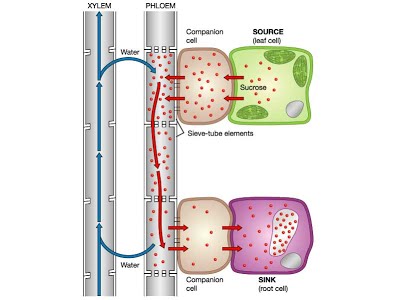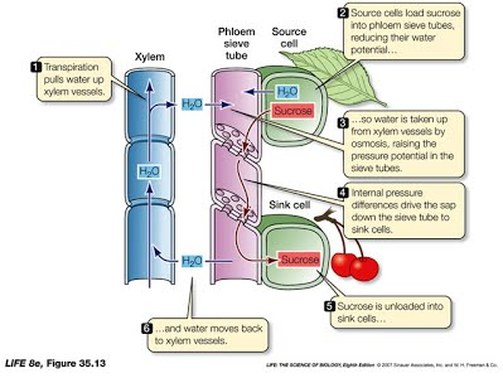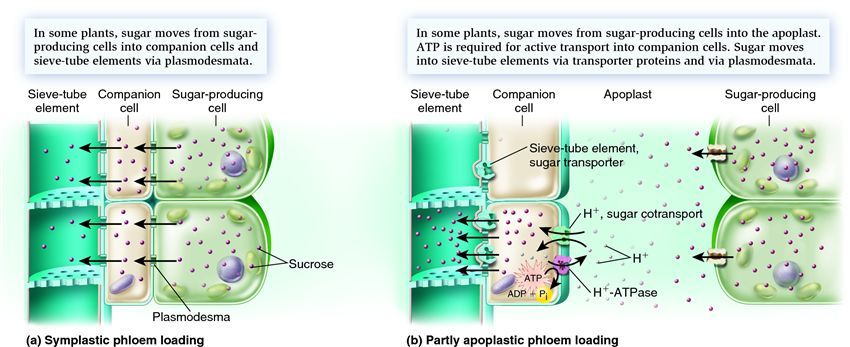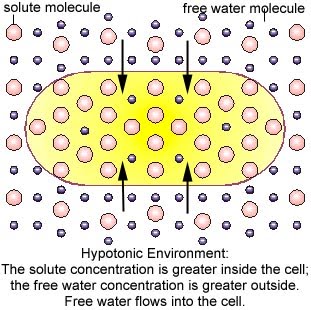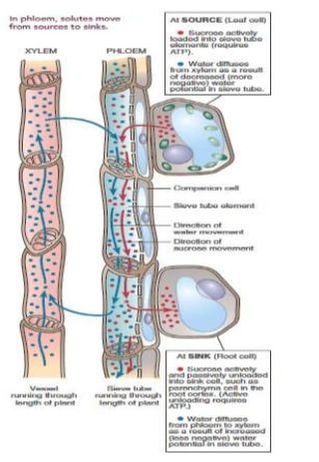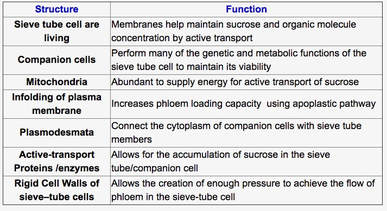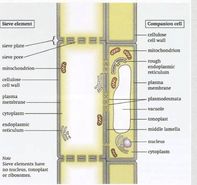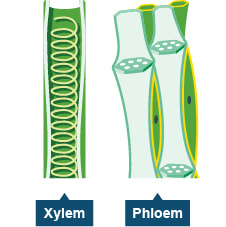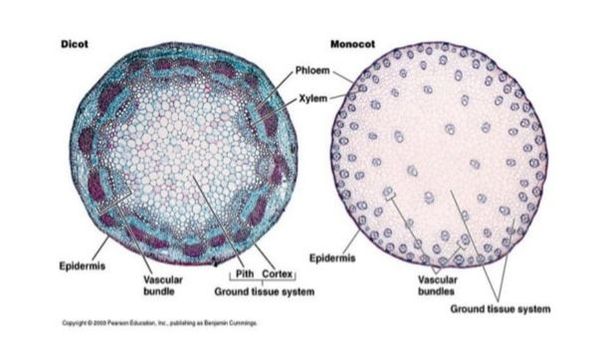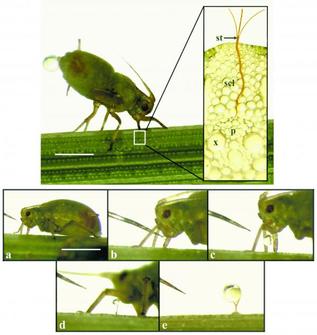- IB Style Question Banks with Solution
- IB DP Biology SL- IB Style Practice Questions with Answer-Topic Wise-Paper 1
- IB DP Biology HL- IB Style Practice Questions with Answer-Topic Wise-Paper 1
- IB DP Biology SL- IB Style Practice Questions with Answer-Topic Wise-Paper 2
- IB DP Biology HL- IB Style Practice Questions with Answer-Topic Wise-Paper 2
9.2 Transport in the Phloem of Plants
Essential Idea:
Structure and function are correlated in the phloem of plants
Understandings:
- Plants transport organic compounds from sources to sinks
- Active transport is used to load organic compounds into phloem sieve tubes at the source
- High concentrations of solutes in the phloem at the source lead to water uptake by osmosis
- Incompressibility of water allows transport along hydrostatic pressure gradients
- Raised hydrostatic pressure causes the contents of the phloem to flow towards sinks
Applications:
- Structure-function relationships of phloem sieve tubes
Skills:
- Identification of xylem and phloem in microscope images of stem and root
- Analysis of data from experiments measuring phloem transport rates using aphid stylets and radioactively-labelled carbon dioxide
- Define translocation, phloem sap, source and sink.
- List example source and sink tissues.
- State that phloem transport is bidirectional.
- Outline why pressure in the phloem increases due to the movement of water into the phloem.
- State that sucrose is the most prevalent solute in phloem sap.
- Outline why sucrose is used for phloem transport, as opposed to glucose.
- Describe the active transport of sucrose into the phloem via a co-transport protein.
- State that the phloem becomes hypertonic to xylem due to the active transport of sucrose into the phloem.
- State that water moves into the phloem by osmosis.
- State that water moves from area of higher pressure to area of lower pressure and that the movement of water also moves the solutes dissolved in it.
- State that the function of phloem includes loading of carbohydrates at a source, transport of carbohydrates through the plant, and unloading of carbohydrates at a sink.
- Outline the structure and function of sieve tube cells, with specific mention of the rigid cell wall and sieve plates.
- Outline the structure and function of companion cells, with specific mention of mitochondria and cell membrane infolding.
- State two ways xylem cells can be identified in cross sections of stem and root.
- Identify xylem given microscope images of stem and root.
- Identify phloem within the vascular bundle of a stem and root.
- State that aphids consume phloem sap as the main component of their diet.
- Outline how aphids have been used to measure the rate of flow and composition of phloem sap.
- Outline how radioactive carbon isotopes are used to study translocation.
Topic 9.2: Transport in the Phloem of Plants
In the Transport in the Phloem unit we will learn that the phloem is the living tissue that transports glucose and other soluble compounds to parts of the plant where needed. This transport process is called translocation
This unit will last 3 school days
Essential idea:
- Structure and function are correlated in the phloem of plants.
Nature of science:
- Developments in scientific research follow improvements in apparatus—experimental methods for measuring phloem transport rates using aphid stylets and radioactively-labelled carbon dioxide were only possible when radioisotopes became available. (1.8)
- Outline how radioactive carbon isotopes are used to study translocation.
9.2 U 1 Plants transport organic compounds from sources to sinks.
- Define translocation, phloem sap, source and sink.
- List example source and sink tissues.
- State that phloem transport is bidirectional.
The phloem is composed of living tissue called sieve tube members (lack a nucleus) that are joined end to end to form a tube that conducts food materials throughout the plant. They are bordered by companion cells that carry out the cellular functions of a sieve-tube element. Phloem tubes can carry sugars and amino acids in a variety of directions; depending on where the source and the sinks are located (sometimes roots can be sources or sinks).
Sources produce sugars by photosynthesis in leaves or green stems or by hydrolysis of starch in storage vessels (germinating seeds or roots/tubers) and deliver these products via the phloem to the sink (roots, buds, stem, seeds, and fruits). At the source, sugar and other organic molecules are loaded into the sieve tube members thus increasing solute concentration within the sieve tube cells (decreases water potential).
Water from surrounding tissues, enters the sieve tube members by osmosis following a concentration gradient.. The water absorbed into the sieve tube creates hydrostatic pressure that forces the phloem sap to flow (bulk flow) towards the sink.
9.2 U 2 Incompressibility of water allows transport along hydrostatic pressure gradients.
- Outline why pressure in the phloem increases due to the movement of water into the phloem.
At normal temperature, the compressibility of water is so low that it can be considered incompressible. Any change in pressure at one end of the transport vessel will result in an equal change in pressure at the other end of the transport vessel. This allows phloem sap to move up or down, with or against gravity, as it moves from source to sink.
Build-up of sucrose and solutes, causes water to enter the companion cells through osmosis. The incompressibility of water and ridged cell walls causes a build-up of pressure. Water flows from high pressure to low pressure
Sucrose is used as an energy source at the sink for growth or converted to starch for storage, reducing the amount of sucrose and thus reducing osmotic pressure. Water that carried the solute is drawn back into the xylem
9.2 U 3 Active transport is used to load organic compounds into phloem sieve tubes at the source
- State that sucrose is the most prevalent solute in phloem sap.
- Outline why sucrose is used for phloem transport, as opposed to glucose.
- Describe the active transport of sucrose into the phloem via a co-transport protein.
At the source sugars are loaded through active transport in a process called phloem loading
In some plants sugars travel through cell walls from mesophyll cells to cell walls of companion cells and some sieve cells. Sugar is then actively transported into the phloem by a sucrose transport protein (Apoplast Pathway). Protons are pumped out of the companion cells from the tissues by active transport, using ATP as an energy source. This creates a proton gradient. H+ binds with sucrose and flows back into the companion cell-sieve tube complex through a co-transport protein, following its concentration gradient, and pulling sucrose molecule with it into the cell.
In other plants, sucrose can travel between cells through connections called plasmodesmata (symplast route). Once the sucrose reaches the companion cell, it is converted to an oligosaccharide, which maintains the sucrose concentration gradient
9.2 U 4 High concentrations of solutes in the phloem at the source lead to water uptake by osmosis
- State that the phloem becomes hypertonic to xylem due to the active transport of sucrose into the phloem.
- State that water moves into the phloem by osmosis.
9 2 U.5 Raised hydrostatic pressure causes the contents of the phloem to flow towards sinks.
- State that water moves from area of higher pressure to area of lower pressure and that the movement of water also moves the solutes dissolved in it.
The Pressure Flow Hypothesis
- The proposes that water containing food molecules flows under pressure through the phloem.
- The pressure is created by the difference in water concentration of the solution in the phloem and the relatively pure water in the nearby xylem ducts.
- At their “source” — the leaves — sugars are pumped by active transport into the companion cells and sieve elements of the phloem.
- As sugars (and other products of photosynthesis) accumulate in the phloem, water enters by osmosis.In the figure, sugar molecules are represented in black, water molecules in red.)
- Turgor pressure builds up in the sieve elements (similar to the creation of root pressure).
- As the fluid is pushed down (and up) the phloem, sugars are removed by the cortex cells of both stem and root (the “sinks”) and consumed or converted into starch.
- Starch is insoluble and exerts no osmotic effect.
- Therefore, the osmotic pressure of the contents of the phloem decreases.
- Finally, relatively pure water is left in the phloem, and this leaves by osmosis and/or is drawn back into nearby xylem vessels by the suction of transpiration-pull.
9.2 A 1 Structure–function relationships of phloem sieve tubes.
- State that the function of phloem includes loading of carbohydrates at a source, transport of carbohydrates through the plant, and unloading of carbohydrates at a sink.
- Outline the structure and function of sieve tube cells, with specific mention of the rigid cell wall and sieve plates.
- Outline the structure and function of companion cells, with specific mention of mitochondria and cell membrane infolding
9.2 S 1 Identification of xylem and phloem in microscope images of stem and root
- State two ways xylem cells can be identified in cross sections of stem and root.
- Identify xylem given microscope images of stem and root.
- Identify phloem within the vascular bundle of a stem and root.
9.2 S 2 Analysis of data from experiments measuring phloem transport rates using aphid stylets and radioactively-labelled carbon dioxide.
- State that aphids consume phloem sap as the main component of their diet.
- Outline how aphids have been used to measure the rate of flow and composition of phloem sap.
Radioactively labeled carbon-14 contained within CO2 can be fixed by plants by photosynthesis . The carbon in these sugars created by photosynthesis, is metabolized by the plant and will be found in different molecules within the plant. This carbon can be detected using film or radiation detectors. Therefore the movement, use, and formation of these molecules can be traced
Aphid uses stylet to tap into phloem. The aphid body cut from stylet after stylet inserted into phloem. The phloem sap continues flowing through stylet. Analyse sap from solutes/carbohydrates. Plants are grown in radioactive CO2 which becomes incorporated into carbohydrates produced by plant. Radioactive-labeled carbon can be detected in the phloem sap. Stylets placed at different parts of the plant can show rate of movement of phloem sap.

